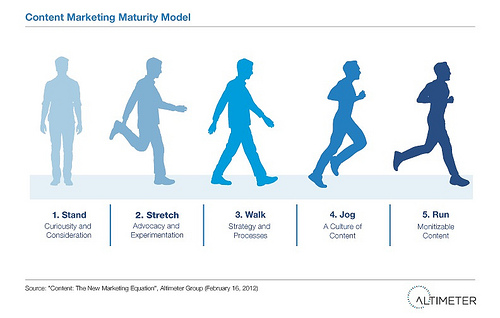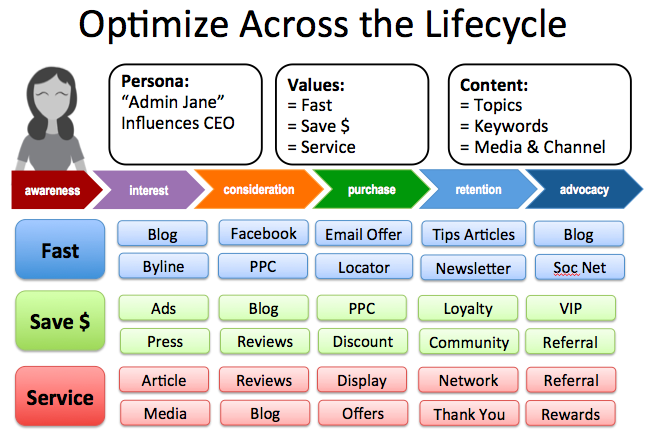 Content marketing is all the rage, though brands still struggle to attract the right audience, engage readers and convert them to buyers. Simply publishing content is no guarantee anyone is going to see it – or that they’d even want to, if quantity is currently trumping quality.
Content marketing is all the rage, though brands still struggle to attract the right audience, engage readers and convert them to buyers. Simply publishing content is no guarantee anyone is going to see it – or that they’d even want to, if quantity is currently trumping quality.
Great content isn’t great until it’s discovered, consumed and shared, says Lee Odden, our CEO at TopRank Online Marketing and SES New York speaker. Lee gave his Creative Content Marketing: Winning Hearts, Minds & Wallets presentation this morning to a room packed with marketers striving to improve their content strategy.
One example that highlights the importance of optimization for search, social sharing and consumption is this infographic novel from a company called Hostway. The authors took what could have been quite a dry, boring subject – internet security – and used a tale of zombies to resuscitate their message. The content itself was fantastic, though as Lee pointed out, it was difficult to share, lacking social share buttons in the PDF.
“Whether social outreach, advertising or email marketing were used, the promotion of a remarkable content object should factor in the ability to amplify increased awareness,” Lee said. “That means optimizing the content object for social sharing and discovery as well as for discovery through search.”
An infographic novel such as this one is a fantastic opportunity for content repurposing, yet several months after its release, images from the novel appeared in Google Image search only from the people – like Lee – who had taken screen captures and written about it.

That is a great example of content marketing in the stretching phase of Altimeter’s Content Marketing Maturity model; they are experimenting, their content is there, but their promotion strategy and processes are developing.
At the other end of the spectrum, you’ll find companies like General Mills, who use their Tablespoon recipe site not only as a marketing tool, but as an additional revenue stream. Their content is very visually engaging and they’ve built an active community around recipes and cooking tips featuring their own products. The site acts acts as a hub for their social channels; they even cross-promote their other brands in ads on the site. This is just one of many sites General Mills owns, with such high quality visual content that they sell their own stock photography.
Your content has to be customer-centric and according to Lee, that’s what’s missing in brand content strategies. We have to know how people discover, consume and act on content. It’s about what your audience wants to hear, not what you want to say.
It’s Not Just About Customers
This is where creativity is essential, Lee said. Yes, you need to find out what customers want and give it to them. However, you also need to take a leadership position and show people things they may not have even thought of before. As Henry Ford said, “If I listened to my customers, we’d still be riding horses.”
Search is based on demand existing, identifying that demand and answering it with content. Content marketing is about demand creation – creating something so interesting people didn’t even know they were looking for it. Lee shared his winning content marketing formula:
- Brand leadership
- Customer empathy
- Storytelling & Creativity
Each aspect is critical; any two together may result in good content, but you need your content to be great, especially in competitive industries. He recommends the Optimize 360 model to help marketers understand and always keep in mind the importance of optimizing for attraction, engagement and conversion.

Further, marketers need to optimize across the lifecycle of each piece of content to get maximum value from their content marketing investments. Lee shared 5 sources of inspiration to help marketers get their content creative on.
5 Creative Content Sourcing Ideas
1. Visualize trends to get a bigger picture look at your keywords and be inspired. Try semrush.com to see what competitors are showing up for organically, Google Keywords to see how often people search on a particular phrase. Or you might try the following:
- Use Majestic SEO anchor text to see what you (or your competitors) get the best links from.
- Do a search on socialmention.com and export a list of the words that are most often associated with your keywords.
- Try ubersuggest.com, which will scrape the autosuggestions from Google Search, News and even Recipes alphabetically and across multiple languages.
Now plug your list of keywords into Wordle.net to see a visualization of your topic.
2. Use your own site. Do you have an internal search engine? See which queries prompt people to search again and create content around that topic. Or, when people fill out forms on your site, analyze the content for word frequency. For example, your contact form may have an open text field; analyze that to surface ideas for content. See which question-oriented queries are actually driving traffic to your site. Don’t forget to check your Google Webmaster Tools as well.
3. Frontline staff. Talk to your salespeople. What kinds of questions are people asking them? Can they bcc your content team when they respond to interesting questions via email? The content team could then anonymize and rewrite it into a blog post.
4. Become a publisher. Review planned stories in editorial calendars to get inspired. Watch how magazines structure content; they may have short and long form content, recurring features, monthly or weekly themes, etc. Think like a newspaper publisher and be objective. Work on your storytelling skills by modeling your content after TV shows – what are they doing to make their content interesting and how can you emulate that?
5. Know your customer journey. Understand your customer buying cycle and create content to meet the information needs of your consumer as they go through the buying cycle.
Lee also recommends 4 different types of content for a diverse, engaging content mix:
- Repurposed
- Cocreated
- Evergreen
- Curated
See an explanation and examples of each in his 4 Types of Killer Content post. Lee also offered a sample content plan template, to help marketers get organized and track the successes of each of their content efforts.
The content marketing opportunity is massive. Do you have a plan in place to attract, engage and convert your audience with high quality content?


